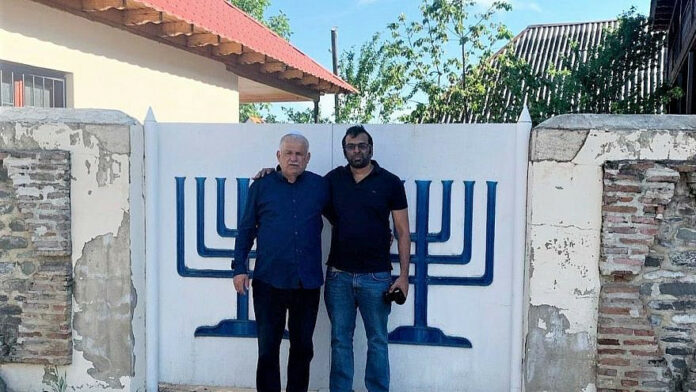
AZERBAIJAN (JNS) – Timur Natalemov, the caretaker of two, 19th-century synagogue buildings in the remote northern Azerbaijan town of Oghuz, died on Feb. 24. A family member told JNS that he was 66 years old.
Join our WhatsApp groupSubscribe to our Daily Roundup Email
Azerbaijan, a nation of about 10.4 million, boasts the most Jews of any Muslim country—between 10,000 and 30,000. It was the rare and adventurous tourist who ventured to Oghuz to learn more about Azerbaijan’s Jewish history, Namatelov told this reporter on a 2022 visit. He would lead synagogue tours for those who did arrive, mostly from Israel and Europe.
Oghuz, which is not far from Chechnya, once had a sizable Jewish community, but today, its Jewish population number between 30 and 40. They are Mountain Jews, also called Jews of the Caucasian Mountains, regarded by some as part of Mizrahi Judaism.
Beyond Oghuz’s two synagogues, Azerbaijan is home to four others.
When visitors who wanted to know more about Jewish Oghuz history arrived at the two locked synagogue buildings on days other than Shabbat, neighbors knew to call Natalemov. A well-known figure in the town of 7,000, he was always happy to show guests around. He concluded tours by handing visitors yarmulkes and requesting that they wear them whenever they might travel to the Western Wall in Jerusalem.
Natalemov’s responsibilities pertained to the Lower Quarter—to the Ashagi Mahalla Synagogue on Gudrat Aghakishiyev Street. The architect who built the 1849 shul is buried on the grounds, and the original wooden platforms that held the two-story building remain intact. The Upper Quarter, or Yukhari Mahalla Synagogue, dates to 1897 and was built under the auspices of Rabbi Baruch Ben Chanuk. With blue menorahs painted on their gates, both shuls are unmistakable.
He politely asked visitors to remove their shoes
Natalemov would tell tourists that Jews there didn’t fear that their houses of worship would be vandalized. They didn’t worry about antisemitism. Security devices or metal detectors were not required for entry, though he would politely ask visitors to remove their shoes before going into a synagogue.
In the 1930s, Oghuz’s Jewish population peaked at 2,000. A typhus outbreak when Natalemov’s parents were alive claimed many lives, Jewish and otherwise. In Mountain Jewish cemeteries, faces are carved on Jewish tombstones—a rarity in Jewish burial practice.
The Soviet era was difficult for Jewish residents and merchants, and many left after synagogues were closed and turned into warehouses, Natalemov would tell visitors. Communists barred Jews from even entering synagogues, though conditions eased slightly under Mikhail Gorbachev in the late 1980s and early 1990s, when Jews were allowed to reclaim their houses of worship.
Like other minorities, Jews were forced to speak Russian and Russianize their names. To this day, many ethnic Azerbaijanis and Jews carry the suffixes -ov and -ski in their names, explained Natalemov.
Following the fall of the Soviet Union in 1991, many Azerbaijani Jews emigrated to the United States or Israel. That included Natalemov’s son and other relatives. Aid from Azerbaijani Jews living abroad supported much-needed renovations; the two synagogues were restored in 2006. The Oghuz community, which has no rabbis, meets for Shabbat and holiday prayers. Many local Muslims join them, while Jews show up at mosques to celebrate Muslim holidays with their neighbors.
